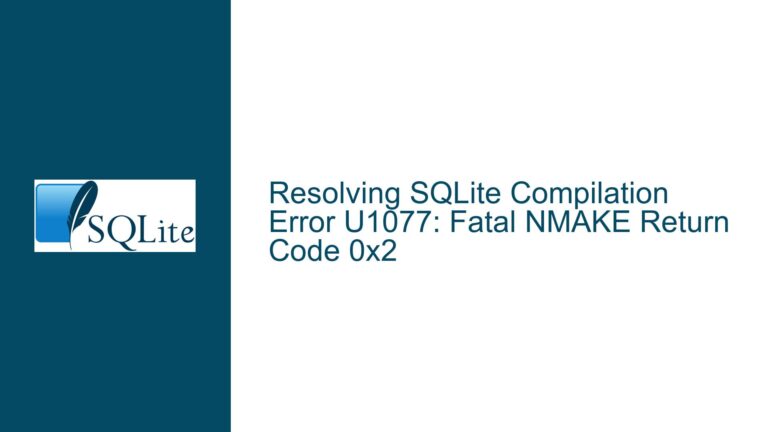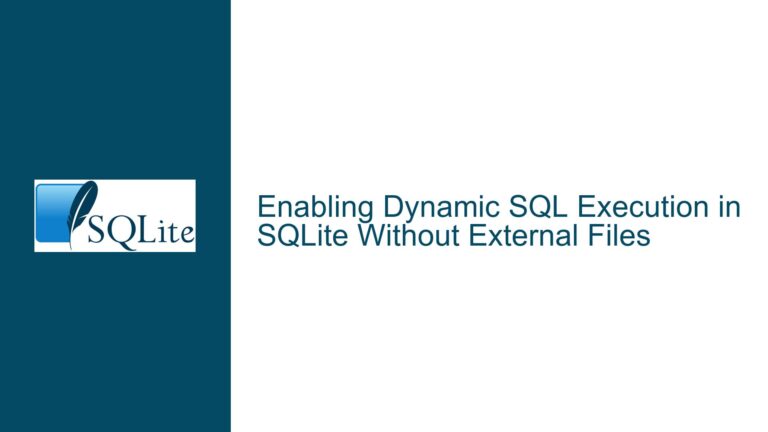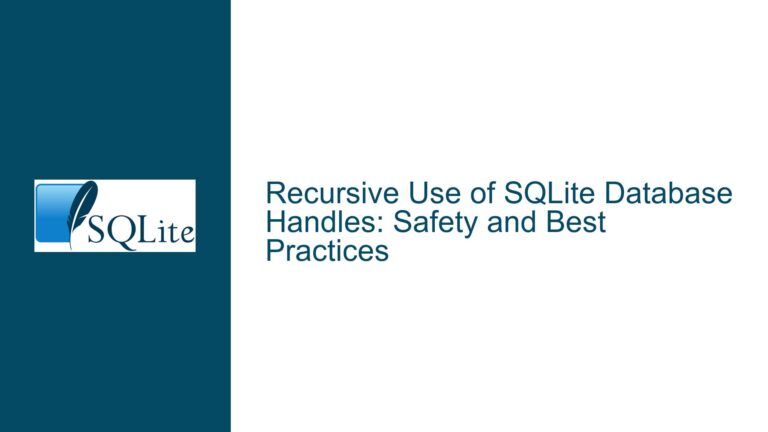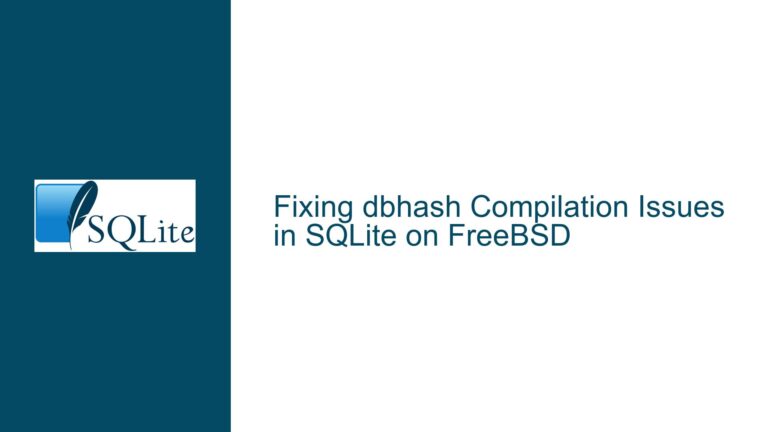Creating and Attaching Multiple In-Memory Databases in SQLite
Understanding the Need for Multiple In-Memory Databases
The core issue revolves around the creation and attachment of multiple in-memory databases within SQLite. In-memory databases are a powerful feature of SQLite, allowing for fast, temporary storage that resides entirely in RAM. This is particularly useful for testing scenarios, such as simulating user concurrency, where the overhead of file-based databases can be a bottleneck. However, the challenge arises when one needs to work with multiple in-memory databases simultaneously, especially when these databases need to be shared across different connections within the same process.
The primary goal is to create multiple in-memory databases, each with a unique identifier, and to attach these databases to different SQLite connections without resorting to file-based storage. This requires a deep understanding of SQLite’s URI filenames, the cache=shared parameter, and the newer vfs=memdb virtual file system introduced in SQLite 3.36.0. The discussion also touches upon the deprecated nature of shared cache and the importance of enabling URI support for certain functionalities.
Exploring the Limitations and Missteps in Current Approaches
Several approaches were attempted to achieve the goal of creating and attaching multiple in-memory databases. The first approach involved using the file::memory:?cache=shared URI format, which was intended to create a shared in-memory database. However, this resulted in only a single database instance being created, likely due to the cache=shared parameter causing the same memory space to be reused across different connection attempts.
Another approach involved using the file:dbName?mode=memory&cache=shared format, but this led to the creation of files on the filesystem, which was not the desired outcome. The intention was to work entirely in memory without any file-based storage. This misstep highlights the importance of understanding the nuances of SQLite’s URI handling and the implications of different parameters.
The use of the vfs=memdb virtual file system was also explored, but initial attempts resulted in files being created on the filesystem. This was later attributed to the lack of URI support being enabled in the SQLite build. Once URI support was enabled, the vfs=memdb approach worked as expected, allowing for the creation of multiple in-memory databases that could be shared across different connections within the same process.
Step-by-Step Solutions for Creating and Attaching Multiple In-Memory Databases
To successfully create and attach multiple in-memory databases in SQLite, follow these detailed steps:
1. Ensure URI Support is Enabled:
Before attempting to use URI filenames or the vfs=memdb virtual file system, ensure that URI support is enabled in your SQLite build. This can be done by compiling SQLite with the SQLITE_USE_URI flag or by using a precompiled version of SQLite that includes URI support. Without URI support, attempts to use URI-based filenames will result in files being created on the filesystem, which is not the desired outcome.
2. Use the vfs=memdb Virtual File System:
Starting with SQLite 3.36.0, the vfs=memdb virtual file system provides a way to create in-memory databases that can be shared across different connections within the same process. To use this feature, you need to specify the vfs=memdb parameter in the URI when attaching the database. For example:
ATTACH DATABASE 'file:/memdb1?vfs=memdb' AS aux1;
ATTACH DATABASE 'file:/memdb2?vfs=memdb' AS aux2;
This will create two in-memory databases, aux1 and aux2, which can be accessed from different connections within the same process.
3. Attach In-Memory Databases to Multiple Connections:
Once the in-memory databases are created using the vfs=memdb virtual file system, you can attach them to multiple connections. For example, in Python, you can do the following:
from sqlite3 import connect, sqlite_version
assert sqlite_version >= '3.36.0'
script = """
ATTACH DATABASE 'file:/memdb1?vfs=memdb' AS aux1;
ATTACH DATABASE 'file:/memdb2?vfs=memdb' AS aux2;
CREATE TABLE aux1.t(id INTEGER PRIMARY KEY);
INSERT INTO aux1.t VALUES (1), (2);
CREATE TABLE aux2.t(id INTEGER PRIMARY KEY);
INSERT INTO aux2.t VALUES (3), (4);
"""
c = connect(":memory:")
c.executescript(script)
print("from c.aux1", c.execute("SELECT * FROM aux1.t").fetchall())
print("from c.aux2", c.execute("SELECT * FROM aux2.t").fetchall())
d = connect(":memory:")
d.executescript(script)
print("from d.aux1", d.execute("SELECT * FROM aux1.t").fetchall())
print("from d.aux2", d.execute("SELECT * FROM aux2.t").fetchall())
This script creates two in-memory databases, aux1 and aux2, and attaches them to two different connections, c and d. The data inserted into these databases can be accessed from both connections, demonstrating that the in-memory databases are shared across connections.
4. Avoid Common Pitfalls:
When working with multiple in-memory databases, it’s important to avoid common pitfalls such as reusing the same database name within a single connection. For example, attempting to attach two different databases with the same name will result in an error:
ATTACH DATABASE 'file:/memdb1?vfs=memdb' AS aux1;
ATTACH DATABASE 'file:/memdb2?vfs=memdb' AS aux1; -- This will cause an error
Ensure that each attached database has a unique name within the context of the connection.
5. Verify the Correctness of Your Implementation:
After setting up your in-memory databases and attaching them to multiple connections, verify that the data is correctly shared across connections. This can be done by inserting data into one connection and querying it from another. For example:
c.execute("INSERT INTO aux1.t VALUES (5)")
print("from d.aux1", d.execute("SELECT * FROM aux1.t").fetchall())
If the data inserted from connection c is correctly retrieved from connection d, then your implementation is working as expected.
6. Consider the Deprecation of Shared Cache:
The cache=shared parameter, which was previously used to share in-memory databases across connections, is now considered deprecated. It is recommended to use the vfs=memdb virtual file system instead, as it provides a more modern and efficient way to achieve the same goal. The vfs=memdb approach does not rely on shared cache and is therefore more robust and future-proof.
7. Handle Edge Cases and Errors:
When working with in-memory databases, be prepared to handle edge cases and errors that may arise. For example, if you encounter the error "SQL logic error database aux1 is already in use," it likely means that you are attempting to attach a database with a name that is already in use within the current connection. Double-check your code to ensure that each attached database has a unique name.
8. Optimize for Performance:
In-memory databases are inherently fast, but there are still ways to optimize their performance. For example, avoid unnecessary schema changes or large transactions that could impact the performance of your in-memory databases. Additionally, consider the memory usage of your in-memory databases, especially if you are working with large datasets. While in-memory databases are fast, they are also limited by the amount of available RAM.
9. Leverage SQLite’s Documentation and Community:
SQLite’s official documentation and community forums are valuable resources when working with in-memory databases. The documentation provides detailed information on URI filenames, the vfs=memdb virtual file system, and other relevant features. The community forums, such as the one where this discussion took place, are a great place to seek help, share knowledge, and learn from others’ experiences.
10. Test Thoroughly:
Finally, thoroughly test your implementation to ensure that it meets your requirements. This includes testing for concurrency, data integrity, and performance. By rigorously testing your in-memory databases, you can identify and address any issues before they become problems in a production environment.
In conclusion, creating and attaching multiple in-memory databases in SQLite is a powerful technique that can greatly enhance the performance and flexibility of your applications. By following the steps outlined above, you can successfully create and manage multiple in-memory databases, share them across different connections, and avoid common pitfalls. With a deep understanding of SQLite’s features and careful attention to detail, you can leverage in-memory databases to their fullest potential.






